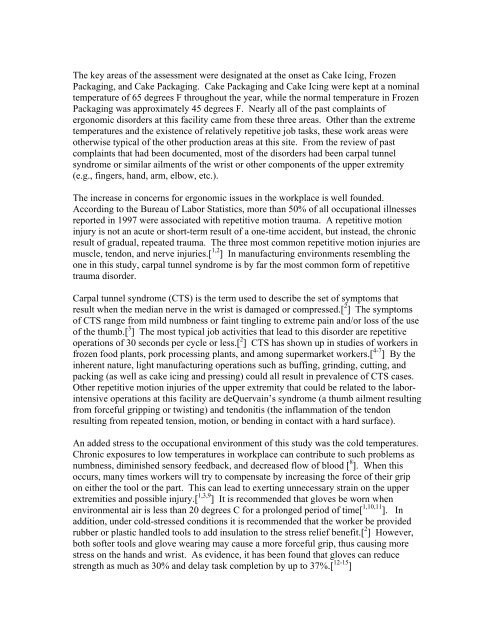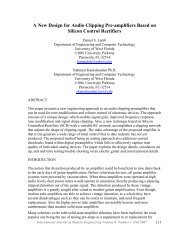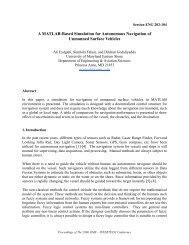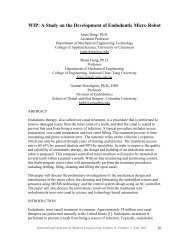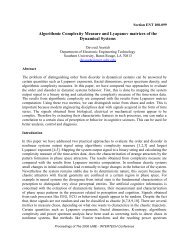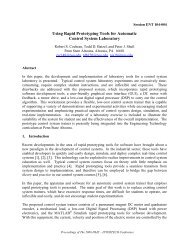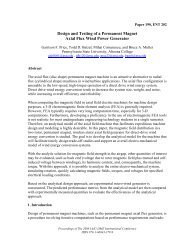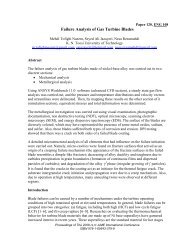The Effects of Coupling Repetitive Motion Tasks With a ... - IJME
The Effects of Coupling Repetitive Motion Tasks With a ... - IJME
The Effects of Coupling Repetitive Motion Tasks With a ... - IJME
Create successful ePaper yourself
Turn your PDF publications into a flip-book with our unique Google optimized e-Paper software.
<strong>The</strong> key areas <strong>of</strong> the assessment were designated at the onset as Cake Icing, Frozen<br />
Packaging, and Cake Packaging. Cake Packaging and Cake Icing were kept at a nominal<br />
temperature <strong>of</strong> 65 degrees F throughout the year, while the normal temperature in Frozen<br />
Packaging was approximately 45 degrees F. Nearly all <strong>of</strong> the past complaints <strong>of</strong><br />
ergonomic disorders at this facility came from these three areas. Other than the extreme<br />
temperatures and the existence <strong>of</strong> relatively repetitive job tasks, these work areas were<br />
otherwise typical <strong>of</strong> the other production areas at this site. From the review <strong>of</strong> past<br />
complaints that had been documented, most <strong>of</strong> the disorders had been carpal tunnel<br />
syndrome or similar ailments <strong>of</strong> the wrist or other components <strong>of</strong> the upper extremity<br />
(e.g., fingers, hand, arm, elbow, etc.).<br />
<strong>The</strong> increase in concerns for ergonomic issues in the workplace is well founded.<br />
According to the Bureau <strong>of</strong> Labor Statistics, more than 50% <strong>of</strong> all occupational illnesses<br />
reported in 1997 were associated with repetitive motion trauma. A repetitive motion<br />
injury is not an acute or short-term result <strong>of</strong> a one-time accident, but instead, the chronic<br />
result <strong>of</strong> gradual, repeated trauma. <strong>The</strong> three most common repetitive motion injuries are<br />
muscle, tendon, and nerve injuries.[ 1,2 ] In manufacturing environments resembling the<br />
one in this study, carpal tunnel syndrome is by far the most common form <strong>of</strong> repetitive<br />
trauma disorder.<br />
Carpal tunnel syndrome (CTS) is the term used to describe the set <strong>of</strong> symptoms that<br />
result when the median nerve in the wrist is damaged or compressed.[ 2 ] <strong>The</strong> symptoms<br />
<strong>of</strong> CTS range from mild numbness or faint tingling to extreme pain and/or loss <strong>of</strong> the use<br />
<strong>of</strong> the thumb.[ 3 ] <strong>The</strong> most typical job activities that lead to this disorder are repetitive<br />
operations <strong>of</strong> 30 seconds per cycle or less.[ 2 ] CTS has shown up in studies <strong>of</strong> workers in<br />
frozen food plants, pork processing plants, and among supermarket workers.[ 4-7 ] By the<br />
inherent nature, light manufacturing operations such as buffing, grinding, cutting, and<br />
packing (as well as cake icing and pressing) could all result in prevalence <strong>of</strong> CTS cases.<br />
Other repetitive motion injuries <strong>of</strong> the upper extremity that could be related to the laborintensive<br />
operations at this facility are deQuervain’s syndrome (a thumb ailment resulting<br />
from forceful gripping or twisting) and tendonitis (the inflammation <strong>of</strong> the tendon<br />
resulting from repeated tension, motion, or bending in contact with a hard surface).<br />
An added stress to the occupational environment <strong>of</strong> this study was the cold temperatures.<br />
Chronic exposures to low temperatures in workplace can contribute to such problems as<br />
numbness, diminished sensory feedback, and decreased flow <strong>of</strong> blood [ 8 ]. When this<br />
occurs, many times workers will try to compensate by increasing the force <strong>of</strong> their grip<br />
on either the tool or the part. This can lead to exerting unnecessary strain on the upper<br />
extremities and possible injury.[ 1,3,9 ] It is recommended that gloves be worn when<br />
environmental air is less than 20 degrees C for a prolonged period <strong>of</strong> time[ 1,10,11 ]. In<br />
addition, under cold-stressed conditions it is recommended that the worker be provided<br />
rubber or plastic handled tools to add insulation to the stress relief benefit.[ 2 ] However,<br />
both s<strong>of</strong>ter tools and glove wearing may cause a more forceful grip, thus causing more<br />
stress on the hands and wrist. As evidence, it has been found that gloves can reduce<br />
strength as much as 30% and delay task completion by up to 37%.[ 12-15 ]


